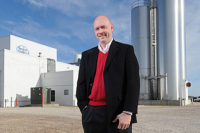Processing cheese and whey powder
When Dairy Foodsvisited, the plant was making Swiss cheese, cream cheese and whey powder. Jeff Jirik, vice president and general manager of the Natural Cheese division, says Swiss cheese is among the most difficult cheeses to make because of a myriad of environmental factors. First, milk needs to be at the right temperature. Then there are the fermentation and brining processes. Finished cheeses sit for a specific time in a warm room and then are moved to a cold room to stop the aging. After all that, a Swiss cheese maker has to wait 55 to 60 days before he can judge its body, texture and eye formation.
In Luana, the cheesemaking process begins by filling the horizontal cheese vats (HCV) with milk. Cultures are added to the milk, which has been warmed to the correct temperature. From the HCV, curds and whey are separated, with the whey pumped through stainless steel lines to be processed into powder. The cheese curds are pumped to press vats. Here the curds form themselves into a single slab of cheese, 7 inches tall. The slabs are then cut into 32 separate blocks and conveyed to the brining room. After brining, the cheese is moved to a warm room for curing. The final stop is the cold room, which stops the aging. The 100-pound Swiss cheese blocks are shipped to a cut-and-wrap facility in St. Olaf. This facility also has a smoke curing room to create smoked Swiss products.
Swiss Valley Farms processes more than 1 million pounds of milk daily. With a cheese operation on this scale, naturally there is a lot of whey. (“We can’t make it fast enough,” says Jeff Saforek, vice president and general manager of Dairy Ingredients and Export.) Whey is pumped from the cheesemaking rooms to the powder area. Through reverse osmosis, vacuum evaporation processes and spray drying, Swiss Valley Farms creates whey powders that are packaged in plastic-lined 50-pound paper bags. Each pallet of whey (as well as every ingredient, in fact) has an RFID tag for traceability. The whey is sold domestically and exported.
Cream cheese and Neufchatel cheese are two other important products for Swiss Valley Farms. The company makes 1,260-pound batches of cream cheese and packages it in 3-pound boxes and 30- and 50-pound containers for foodservice accounts domestically and abroad. Customers use the cheeses primarily in baking.
Employee safety, food safety
Safety is on the agenda every day of the year at Luana.
“We have a safety committee that meets once a month and reviews all safety concerns and challenges at the plant and implements solutions and alternatives for preventing accidents from happening,” Rowe says.
Hourly and salaried employees from all departments sit on the committee to provide a good mix of experience and knowledge of the plant. In addition to the monthly safety committee meeting, there are weekly discussions that drive home good work habits, and ongoing training.
The company installed ergonomically designed tools and products, such as fatigue mats, larger handles on knifes and scrappers, carts for moving product and vacuum lifts for heavy product lifting. Supervisors rotate employees hourly on their work station to prevent any injury or fatigue.









